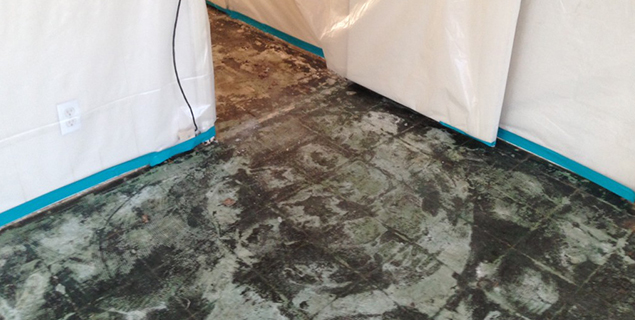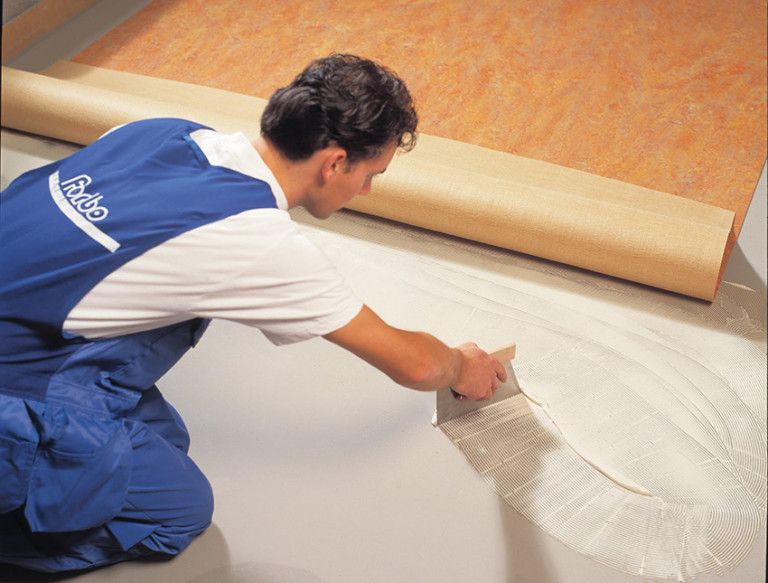When making repairs in the room, I always want to improve the floor. A wide selection of flooring in the construction markets allows you to choose the perfect option for your taste and budget. Whether to lay a noble parquet, choose a modern laminate, lay a carpet or choose a comfortable linoleum - the choice is yours.
The advantages of linoleum are the price, a wide selection of colors, ease of use and durability. But the material has its own characteristics.
Materials
Linoleum is of different types. After reviewing the brief characteristics, making a choice is not difficult. Linoleum happens:
- From natural materials. Such linoleum is made from linseed oil, wood resin and other natural materials. In addition to environmental cleanliness, it does not ignite, does not absorb fat and is resistant to the growth of microorganisms. These are pretty serious advantages.
- From rubber. Relin (aka rubber linoleum) is resistant to moisture and more plastic.
- From PVC. The quality and price of such linoleum depends on the substrate and the number of layers. It is warm, but gives a lot of shrinkage and smells very specific for a very long time. This is not for everyone.
- Alkyd. This species is distinguished by good sound and thermal insulation, but more fragile than the rest. For rooms with frequent attendance, it is not suitable.
- From nitrocellulose. Such a floor will be very beautiful, with a noble sheen, but due to the lack of a substrate it is easily flammable.
Stacking
In order for the coating to last as long as possible and not cause discomfort, linoleum must be correctly laid. There are several styling methods, but one is still true. Laying linoleum without fasteners is a fairly common method, but over time, such a floor will bring inconvenience. Hammering linoleum with nails is unaesthetic, uncomfortable and, at least, dangerous. Lay the coating with a special glue for linoleum - mastic. This is the most convenient and durable way.
Types of mastic for linoleum
On sale there are 2 types that differ in purpose:
- Protective, which is used to restore the coating and protect the floor.
- Adhesive mastic for linoleum. It allows you to firmly lay the floor covering.
Each of the types can be prepared independently, at home, or purchased a ready-made mixture in the market. Professionals prefer to cook mastic on their own, since the mixes should hold linoleum tightly, and the quality depends on the time of manufacture, storage and packaging conditions. It’s quite possible to cook the mastic yourself. But this implies the presence of certain skills, knowledge of the composition of the mixture and the type of linoleum. The main thing is to remember that each type of linoleum has its own composition.
Types of finished compounds
Many types of linoleum mastics sold in stores are universal. Only linoleum without a base requires a special composition. However, before buying, you need to carefully read the composition and recommendations of the manufacturer. These are mainly rubber based mastics, they are suitable for:
- Relin.
- PVC linoleum.
- Linoleum from nitrocellulose.
- Natural linoleum.
Types of homemade mastics
There are several types:
- Casein-emulsion (it is flour). Suitable for rooms in which there will not be much humidity on the floor. Linoleum for such a mastic can be made of PVC or on a fabric basis, the floor can be made of fiberboard, HDF, etc. Such a mastic is suitable for gluing linoleum for another 4 hours from the date of manufacture. Consumption - about two kilograms of the mixture per square meter of coverage.
- Bitumen-rubber mastic. It is suitable for religion, alkyd linoleum and PVC. Its validity is not limited. It is enough to warm the mixture in a water bath and add gasoline. The approximate consumption is one and a half kilograms per square meter.
- Bituminous-chalky mastic (for linoleum of all kinds). You can use up to several days. Consumption is similar to the previous mixture.
- Bituminous-turpentine mastic for coating from PVC and linoleum on a fabric basis. When stored in sealed containers, it is suitable for several months. It takes about one kilogram per square meter of floor.
- Lacquer-chalk. Good for alkyd linoleum, but provided that the base of the floor is concrete, metal or wood. It retains its properties for five hours from the moment of preparation of the mixture.

In the manufacture of mastic for linoleum on waterproof binders, it is necessary to protect hands and mucous membranes. That is, when starting to make the mixture, be sure to wear gloves and safety glasses, and in some cases a respirator. When working with the finished mixture, be sure to monitor the temperature, since some mixtures are valid only in the heated state.
Self laying
If you lay down a new coating yourself, you can avoid spending on expensive services of masters, but you need to have the necessary skills and information. Before laying linoleum, it is imperative to level the floor or prepare it properly, grind and degrease the surface. When laying out linoleum, it is important to remember that gaps in the coating are unacceptable. Before laying, let the rolled linoleum rest in a warm room. Then you can start laying. Mastic is an important element not only in strengthening the adhesion of linoleum and floor, but also a protective heat and sound insulation layer. It is also a good protection against excess moisture. Before distributing the mastic, it is necessary to make sure that the base does not require an additional primer layer, and that the previous layer is dried. It is better to apply the composition to the base with a notched trowel, a layer of about five millimeters.

Linoleum is rolled onto the finished layer, the surface of which must be pressed with a roller or mini-roller. For better adhesion, it is important not to have a physical effect on the floor during the day, after which it is good to clean linoleum, apply protective mastic and wait for an hour and a half to dry.
Protective
Protective mastic for linoleum has several functions:
- Shining.
- Burnout protection.
- Antistatic effect.
- Protection against scratches and heavy dirt.
- Anti-slip coating.
Also, this layer increases the durability of the linoleum. It retains its original appearance longer.
It is necessary to apply protective mastic to perfectly cleaned and dry linoleum. Rub the mastic for linoleum, to shine the floor with a lint-free cloth and carefully ensure that there is no accumulation of the product and stains. If you apply the solution on a damp surface, it is possible to delaminate the composition after a certain time.
The ideal mastic for linoleum repair is cold welding. With its help, you can eliminate the disadvantages of improperly laid cover. For example, to close a hole or damage to the outer surface, strengthen the joints of the dock, make a patch, eliminate dents and bulges, etc.
Manufacturers and consumer reviews
One of the most common manufacturers of mastics on the market is the Swiss company FORBO. According to reviews of consumers and craftsmen, their product line is of good quality. Glue mastic does not give bubbles, does not leave traces of furniture, chair rollers, holds the coating firmly. Protective mastics strengthen the outer layer. Linoleum retains shine for a long time and is protected from pollution.
Well-established German company WEBER. She was distinguished by good quality adhesive mastic. Mastic is easy to use, good at work and has a decent quality result - say the reviews.
Of the Russian manufacturers, the best reviews were collected by the KhimTorgProekt company, which manufactures products under the BITUMAST brand. They produce bituminous mastics of cold and hot application. Their product does not have an acute odor, dries well and reliably fixes linoleum.
Conclusion
So, we found out the main types of mastics. Regardless of whether you do the repair yourself or a team of professionals works, it is important to know the basic information about the materials used in the repair. Thus, you will be reliably protected from dishonest masters and mistakes.